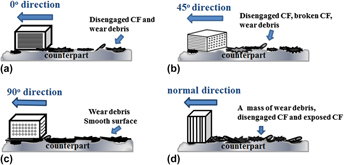Crossref Citations
This article has been cited by the following publications. This list is generated based on data provided by
Crossref.
Kumar, Parshant
and
Srivastava, Vijay Kumar
2018.
Reciprocating sliding tribology of ceramic fiber composites with variation of laminate orientation and surface conformity.
Ceramics International,
Vol. 44,
Issue. 5,
p.
5365.
Dvořáčková, Štěpánka
and
Kroisová, Dora
2020.
Thermal Expansion of Composite System Epoxy Resin/Recycled Carbon Fibers.
Materials Science Forum,
Vol. 994,
Issue. ,
p.
162.
Somberg, Julian
Saravanan, Prabakaran
Vadivel, Hari Shankar
Berglund, Kim
Shi, Yijun
Ukonsaari, Jan
and
Emami, Nazanin
2021.
Tribological characterisation of polymer composites for hydropower bearings: Experimentally developed versus commercial materials.
Tribology International,
Vol. 162,
Issue. ,
p.
107101.
Meng, Fanning
Zhang, Zhenyu
Gao, Peili
Kang, Ruiyang
Boyjoo, Yash
Yu, Jinhong
and
Liu, Tingting
2021.
Excellent tribological properties of epoxy—Ti3C2 with three-dimensional nanosheets composites.
Friction,
Vol. 9,
Issue. 4,
p.
734.
Kumar, Parshant
and
Srivastava, Vijay Kumar
2022.
Chilled Temperature Induced Unidirectional Sliding Characteristics of 2D Woven Carbon Fiber Composites.
Transactions of the Indian Institute of Metals,
Vol. 75,
Issue. 10,
p.
2701.
Suo, Haoyuan
Wei, Zhaohui
Zhang, Kaifu
Deng, Kelin
Cheng, Hui
Luo, Bin
Li, Hailin
Wang, Linxuan
and
Liang, Biao
2022.
Interfacial wear damage of CFRP/Ti-alloy single-lap bolted joint after long-term seawater aging.
Engineering Failure Analysis,
Vol. 139,
Issue. ,
p.
106464.
Yao, Chang-Da
Li, Yong
Zang, Zhi-Wei
Li, Xin-Yang
and
Han, Shun
2024.
Influence of Tempering Temperature on Mechanical and Rotational Bending Fatigue Properties of 40CrNi2MoE Steel.
Materials,
Vol. 17,
Issue. 6,
p.
1377.
Wang, Zhiyong
Ma, Jianguo
Liu, Zhihong
Liu, Zhenfei
Deng, Haoxiang
Su, Yudong
Zhou, Nengtao
Zhai, Hua
and
Wu, Jiefeng
2024.
Comparison of electron-beam-welded joints manufactured by rolled and selective laser melted reduced activation ferritic/martensitic steel.
Journal of Materials Research and Technology,
Vol. 28,
Issue. ,
p.
3514.
Korku, Mihriban
İlhan, Recep
and
Feyzullahoğlu, Erol
2025.
Investigation of effects of environmental conditions on wear behaviors of glass fiber reinforced polyester composite materials.
Polymer Composites,
Vol. 46,
Issue. 1,
p.
355.
